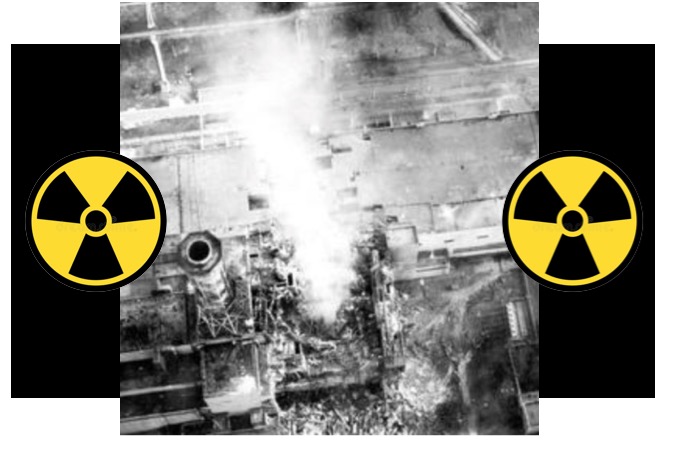CommentsNUCLEAR DISASTER - As one of the world’s largest, and most troubled, nuclear power facilities has become a radioactive pawn in an increasingly savage and internecine war, the atomic clock is about as close to ringing Midnight as it can get.
Yet most of the world seems to be sleeping–or sleepwalking–soundly, either unaware or unruffled by the immediacy of the peril in Ukraine.
How can this be? After cowering under the nuclear menace for nearly eight decades, after Trinity, Hiroshima and Nagasaki, after the big blasts at Novaya Zemlya, Amchitka and the Marshall Islands, after the radioactive disasters at Church Rock, Three Mile Island, Rocky Flats, Chernobyl, Hanford, and Fukushima? How can a demonic technology that has left only death, destruction, environmental ruin, cancer, sterility and genetic mutation as its legacy be treated so cavalierly by so many? We’ve reached the point where even Oliver Stone is pushing the virtues of nuclear power, despite its inextricable ties with the military-industrial complex he’s assailed most of his career.
In large measure, this dismal state of affairs is the consequence of the deepening fractures in the global environmental movement, a large swath of which has desperately embraced nuclear power as an atomic shield–dubious though it will prove to be–against cataclysmic climate change.
The emerging compact between the nuclear industry and some high-profile environmentalists is surely one of the most surreal–and treacherous–alliances of our time. Freelance nuclear shills, such as the odious James Hansen and the clownish George Monbiot, have left carbon footprints that would humble Godzilla by jetting across the world promoting nuclear energy as a kind of technological deus ex machina for the apocalyptic threat of climate change. Hansen has gone so far as to charge that “opposition to nuclear power threatens the future of humanity.” Shamefully, many greens now promote nuclear power as a kind ecological lesser-evilism.
Of course, there’s nothing new about this kind of rationalization for the doomsday machines. The survival of nuclear power has always depended on the willing suspension of disbelief. In the terrifying post-Hiroshima age, most people intuitively detected the symbiotic linkage between nuclear weapons and nuclear power and those fears had to be doused. As a consequence, the nuclear industrial complex concocted the fairy tale of the peaceful atom, zealously promoted by one of the most devious conmen of our time: Edward “H-Bomb” Teller.
After ratting out Robert Oppenheimer as a peacenik and security risk, Teller set up shop in his lair at the Lawrence Livermore Labs and rapidly began designing uses for nuclear power and bombs as industrial engines to propel the post-World War II economy. One of the first mad schemes to come off of Teller’s drafting board was Operation Chariot, a plan to excavate a deep-water harbor at Cape Thornton, near the Inuit village of Point Hope, Alaska, by using controlled (sic) detonations of hydrogen bombs.
In 1958, Teller, the real-life model for Terry Southern’s character Dr. Strangelove, devised a plan for atomic fracking. Working with the Richfield Oil Company, Teller plotted to detonate 100 atomic bombs in northern Alberta to extract oil from the Athabasca tar sands. The plan, which went by the name Project Oilsands, was only quashed when intelligence agencies got word that Soviet spies had infiltrated the Canadian oil industry.
Frustrated by the Canadians’ failure of nerve, Teller soon turned his attentions to the American West. First he tried to sell the water-hungry Californians on a scheme to explode more than 20 nuclear bombs to carve a trench in the western Sacramento Valley to canal more water to San Francisco, the original blueprint for Jerry Brown’s Peripheral Canal. This was followed by a plot to blast off 22 peaceful nukes to blow a hole in the Bristol Mountains of southern California for the construction of Interstate 40. Fortunately, neither plan came to fruition.
Teller once again turned to the oil industry, with a scheme to liberate natural gas buried under the Colorado Plateau by setting off 30 kiloton nuclear bombs 6,000 feet below the surface of the earth. Teller vowed that these mantle-cracking explosions, marketed as Project Gasbuggy, would “stimulate” the flow of natural gas. The gas was indeed stimulated, but it also turned out to be highly radioactive.
More crucially, in 1957 at speech before the American Chemical Society Teller, who later helped the Israelis develop their nuclear weapons program, became the first scientist to posit that the burning of fossil fuels would inevitably yield a climate-altering greenhouse effect, which would feature mega-storms, prolonged droughts and melting ice-caps. His solution? Replace the energy created by coal and gas-fired plants with a global network of nuclear power plants.
Edward Teller’s deranged ideas of yesteryear have now been dusted off and re-marketed by the Nuclear Greens, including James Lovelock, the originator of the Gaia Hypothesis, with no credit given to their heinous progenitor.
There are currently 460 or so operating nukes, some chugging along far past their expiration dates, coughing up 10 percent of global energy demands. Teller’s green disciples want to see nuclear power’s total share swell to 50 percent, which would mean the construction of roughly 2100 new atomic water-boilers from Mogadishu to Kathmandu. What are the odds of all of those cranking up without a hitch?
(Jeffrey St. Clair is editor of CounterPunch. His most recent books are Bernie and the Sandernistas: Field Notes From a Failed Revolution and The Big Heat: Earth on the Brink (with Joshua Frank) He can be reached at: [email protected] or on Twitter @JeffreyStClair3.) Photo: Radioactive steam plumes from the shattered reactor #4 at the Chernobyl nuclear plant. Photo Credit: USFCRFC, IAEA, Imagebank.
















